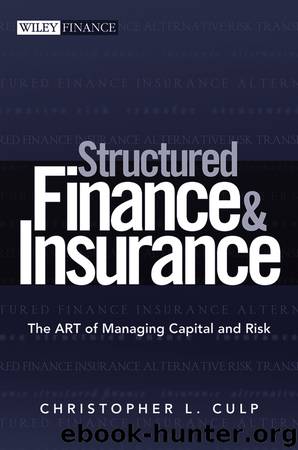Structured Finance and Insurance by Christopher L. Culp

Author:Christopher L. Culp
Language: eng
Format: epub
Publisher: Wiley
Published: 2011-09-01T16:00:00+00:00
Hedge fund participation usually occurs through a master partnership structure in which the fund’s adviser(s) and/or key sponsor(s) are the general partners (GPs). External investment generally comes in the form of limited partner (LP) interests. Exiting a fund often requires an LP to provide the GP with notice well in advance of the planned redemption date. Exits may be further constrained by long minimum initial holding periods or lockout periods.
A major constraint facing many prospective hedge fund investors has always been the risk of a loss of principal. Pension plans and certain other institutional investors, for example, are rarely authorized to engage in investments for which a loss of principal is a real possibility. Until the advent of hedge fund-linked structured securities, participating in hedge fund returns without the full risks of hedge fund partnership investments was essentially impossible.
Private Equity Funds
Private equity is an important source of corporate financing and risk transfer, especially for firms that have difficulty accessing the traditional public securities markets. Private equity includes both venture and nonventure investments. Venture PE is typically associated with firms—often small or medium-sized—in early capitalization stages, whereas nonventure PE includes funding for buyouts, restructurings, distress workouts, and the like.
Private equity is frequently placed through PE funds. A typical PE fund is organized as a partnership, with a general partner (GP) actively managing the specific investments of the fund. Limited partners (LPs) are investors in the fund that agree to fund a certain amount of capital calls, usually over the first 5 to 10 years of the fund.
PE funds have been securitized through a CDO-like process on several occasions. The tranched capital structure of CDOs is a natural fit to private equity collateral. The structuring process greatly increases the range of risk/return opportunities in the fund available for private equity fund investors. In addition, increased liquidity, decreased volatility, increased transparency, and heightened competitiveness (through better benchmarking) are natural consequences for the underlying private equity market as private equity–backed CDOs increase in popularity.
Private equity does, of course, pose some considerable challenges to the structuring process. Some of these challenges are purely structural and legal. LP interests is a fund, for example, are generally transferable only with permission of the GP and even then may be subject to additional restrictions. Other challenges in securitizing PE fund interests arise more from the nature and risks of the PE business itself.
Private equity funds typically have a net cash flow profile over time that resembles the pattern shown in Exhibit 20.1, known as the J-curve. High up-front costs, the ramp-up period, capital calls, and high debt service obligations on what can be substantial amounts of senior debt all lead to substantial cash outflows early in the life of a typical fund. At the same time, distributions on the fund’s investments often do not begin in earnest until well into the life of a fund. The result is a substantial dip in net cash flows early in the life of a fund, followed by a recovery. But from
Download
This site does not store any files on its server. We only index and link to content provided by other sites. Please contact the content providers to delete copyright contents if any and email us, we'll remove relevant links or contents immediately.
The Secrets of Successful Financial Planning by Dan Gallagher(1516)
A Knight's Reward by Catherine Kean(1326)
An American Sickness by Elisabeth Rosenthal(1249)
Against the Gods by Peter L. Bernstein(1101)
FREAKONOMICS by levitt steven d(1087)
America's Bitter Pill: Money, Politics, Backroom Deals, and the Fight to Fix Our Broken Healthcare System by Steven Brill(1073)
SuperFreakonomics by Steven D. Levitt(1073)
America's Bitter Pill by Steven Brill(1050)
The Globetrotter's Guide to Travel Insurance: Travel Smarter, Pay Less, Get the Right Coverge (The Savvy Traveler Series Book 1) by Bauche Michael & Bauche Yvonne(1024)
Risk Management Framework by James Broad(1024)
A Practical Introduction to Security and Risk Management by Bruce Oliver Newsome(1020)
2019 Social Security & Medicare Facts by Michael D. Thomas(1015)
Strategic Risk Taking: A Framework for Risk Management by Aswath Damodaran(1011)
The New Frontier Investors by Jagdeep Singh Bachher Adam D. Dixon & Ashby H. B. Monk(1004)
Game Changers by Rudolf Taschner(1002)
How Our Days Became Numbered: Risk and the Rise of the Statistical Individual by Dan Bouk(991)
The 8 Characteristics of the Awesome Adjuster by Carl van Lamsweerde(927)
SUPERFREAKONOMICS by levitt steven d(921)
The Advisor Playbook: Regain Liberation and Order in your Personal and Professional Life by Duncan MacPherson & Chris Jeppesen(884)
